Coburn J.W. Algebra and Trigonometry
Подождите немного. Документ загружается.


scatter-plot to find the regression equation.
According to the model, what will be the cost of
cable service in 2010? 2015?
Source: 2004–2005 Statistical Abstract of the United States,
page 725, Table 1138.
48. Research and development
expenditures: The
development of new
products, improved health
care, greater scientific
achievement, and other
advances is fueled by huge
investments in research
and development (R & D).
Since 1960, total R & D
expenditures in the United
States have shown a
distinct pattern of growth,
and the data are given in
the table for selected years
from 1960 to 1999. Use
the data to draw a scatter-plot, then use the context
and scatter-plot to find the regression equation.
According to the model, what was spent on R & D
in 1992? In what year did expenditures for R & D
exceed 450 billion?
49. Business start-up costs: As
many new businesses open, they
experience a period where little
or no profit is realized due to
start-up expenses, equipment
purchases, and so on. The data
given shows the profit of a new
company for the first 6 months
of business. Use the data to
draw a scatter-plot, then use the
context and scatter-plot to find
the regression equation. According to the model,
what is the first month that a profit will be earned?
50. Low birth weight: For many
years, the association between
low birth weight (less than
2500 g or about 5.5 lb) and a
mother’s age has been well
documented. The data given are
grouped by age and give the
percent of total births with low
birth weight.
Source: National Vital Statistics Report,
Vol. 50, No. 5, February 12, 2002.
a. Using the median age of each group, use the
data to draw a scatter-plot and decide on an
appropriate form of regression.
standard chromatic scale.
Use the data to draw a
scatter-plot, then use the
context and scatter-plot to
find the regression
equation.
a. What is the frequency
of the “A” note that is
an octave higher than
the one shown?
[Hint: The names
repeat every 12 notes
(one octave), so this
would be the 13th
note in this
sequence.]
b. If the frequency is
370.00 what note is being played?
c. What pattern do you notice for the F#’s in each
octave (the 10th, 22nd, 34th, and 46th notes in
sequence)? Does the pattern hold for all notes?
46. Basketball salaries: In
1970, the average player
salary for a professional
basketball player was about
$43,000. Since that time
player salaries have risen
dramatically. The average
player salary for a
professional player is given
in the table to the right for
selected years. Use the data
to draw a scatter-plot, then
use the context and scatter-
plot to find the regression equation.
Source: Wall Street Journal Almanac.
a. What was the approximate salary for a player
in 1993?
b. Approximately how much will the average
salary be in 2005?
c. In what year did the average salary exceed
$5,000,000?
47. Cost of cable service: The
average monthly cost of
cable TV has been rising
steadily since it became
very popular in the early
1980s. The data given
shows the average monthly
rate for selected years
( ). Use the data to
draw a scatter-plot, then
use the context and
1980 S 0
500 Modeling with Technology II Exponential, Logarithmic, and Other Regression Models MWTII–10
# Note Frequency
1 A 110.00
2 A# 116.54
3 B 123.48
4 C 130.82
5 C# 138.60
6 D 146.84
7 D# 155.56
8 E 164.82
9 F 174.62
10 F# 185.00
11 G 196.00
12 G# 207.66
Year Salary
($1000s)
043
10 260
15 325
20 750
25 1900
27 2200
28 2600
(1970 S 0)
Profit
Month ($1000s)
1
2
3
4
5
6
19
21
20
18
13
5
Year R & D
(billion $)
0 13.7
5 20.3
10 26.3
15 35.7
20 63.3
25 114.7
30 152.0
35 183.2
39 247.0
(1960 S 0)
College Algebra—
Year Monthly
Charge
0 $7.69
5 $9.73
10 $16.78
20 $23.07
25 $30.70
(1980 S 0)
Ages Percent
15–19 8.5
20–24 6.5
25–29 5.2
30–34 5
35–39 6
40–44 8
45–54 10
cob19413_ch0MWT_491-502.qxd 11/25/08 0:47 Page 500
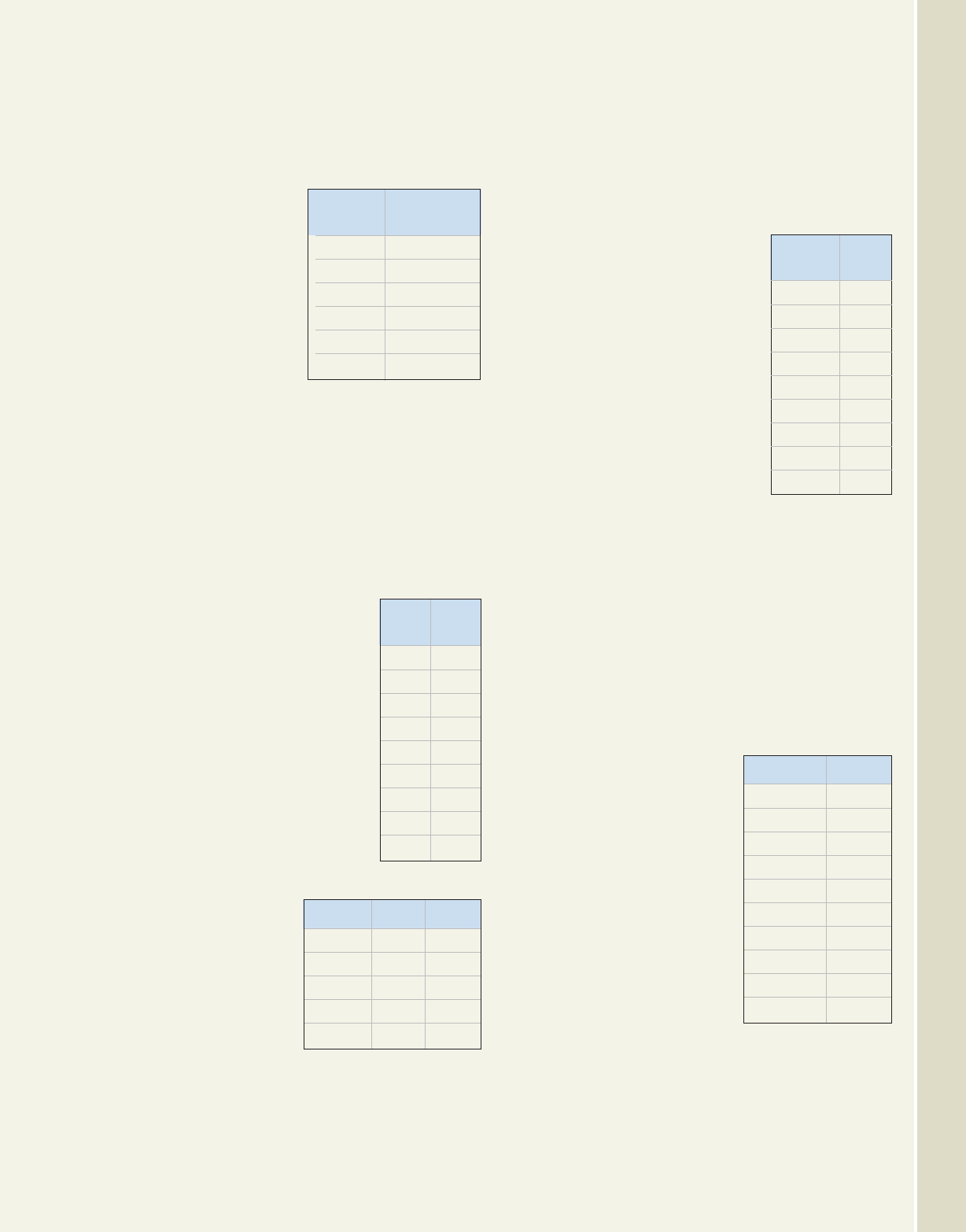
or power regression is most appropriate. Then
(a) find the regression equation and use it to estimate
the average orbital radius of Saturn, given it orbits
the Sun every 29.46 yr, and (b) estimate how many
years it takes Uranus to orbit the Sun, given it has an
average orbital radius of 19.2 AU.
54. Ocean temperatures: The
temperature of ocean water
depends on several factors,
including salinity, latitude,
depth, and density. However,
between depths of 125 m and
2000 m, ocean temperatures are
relatively predictable, as
indicated by the data shown for
tropical oceans in the table. Use
a graphing calculator to draw
the scatter-plot, then use the
scatter-plot, the context, and
any previous experience to
decide whether a polynomial,
exponential, logarithmic, or power regression is
most appropriate (end behavior rules out linear and
quadratic models as possibilities).
Source: UCLA at www.msc.ucla.oceanglobe/pdf/
thermo_plot_lab
a. Find the regression equation and use it to
estimate the water temperature at a depth of
2850 m.
b. If the model were still valid at greater depths,
what is the ocean temperature at the bottom of
the Marianas Trench, some 10,900 m below
sea level?
55. Predator/prey model: In
the wild, some rodent
populations vary inversely
with the number of
predators in the area. Over
a period of time, a
conservation team does an
extensive study on this
relationship and gathers the
data shown. Draw a scatter-
plot of the data and (a) find
a regression equation that
models the data. According
to the model, (b) if there
are 150 predators in the
area, what is the rodent population? (c) How many
predators are in the area if studies show a rodent
population of 3000 animals?
b. Find a regression equation that models the
data. According to the model, what percent of
births will have a low birth weight if the
mother was 58 years old?
51. Growth of cell phone
use: The tremendous
surge in cell phone use
that began in the early
nineties has continued
unabated into the new
century. The total
number of subscriptions
is shown in the table for
selected years, with
and the
number of subscriptions in millions. Use the data
to draw a scatter-plot. Does the data seem to
follow an exponential or logistic pattern? Find the
regression equation. According to the model, how
many subscriptions were there in 1997? How
many subscriptions does your model project for
2005? 2010? In what year will the subscriptions
exceed 220 million?
Source: 2000/2004 Statistical Abstracts of the United States,
Tables 919/1144.
52. Absorption rates of fabric:
Using time lapse photography, the
spread of a liquid is tracked in
one-fifth of a second intervals, as
a small amount of liquid is
dropped on a piece of fabric. Use
the data to draw a scatter-plot,
then use the context and scatter-
plot to find the regression
equation. To the nearest hundredth
of a second, how long will it take
the stain to reach a size of 15 mm?
53. Planetary orbits: The table shown
gives the time required for the first
five planets to make one complete
revolution around the
Sun (in years), along
with the average orbital
radius of the planet in
astronomical units
( million
miles). Use a graphing
calculator to draw the
scatter-plot, then use
the scatter-plot, the
context, and any previous experience to decide
whether a polynomial, exponential, logarithmic,
1 AU 92.96
1990 S 0
MWTII–11 Modeling with Technology II Exponential, Logarithmic, and Other Regression Models 501
Time Size
(sec) (mm)
0.2 0.39
0.4 1.27
0.6 3.90
0.8 10.60
1.0 21.50
1.2 31.30
1.4 36.30
1.6 38.10
1.8 39.00
College Algebra—
Planet Years Radius
Mercury 0.24 0.39
Venus 0.62 0.72
Earth 1.00 1.00
Mars 1.88 1.52
Jupiter 11.86 5.20
Predators Rodents
10 5100
20 2500
30 1600
40 1200
50 950
60 775
70 660
80 575
90 500
100 450
Year Subscriptions
(millions)
0 5.3
3 16.0
6 44.0
8 69.2
12 140.0
13 158.7
(1990 S 0)
Depth Temp
(meters) ( )
125 13.0
250 9.0
500 6.0
750 5.0
1000 4.4
1250 3.8
1500 3.1
1750 2.8
2000 2.5
C
cob19413_ch0MWT_491-502.qxd 30/10/2008 05:09 PM Page 501 EPG 204:MHDQ069:mhcob%0:cob2chMWT2:
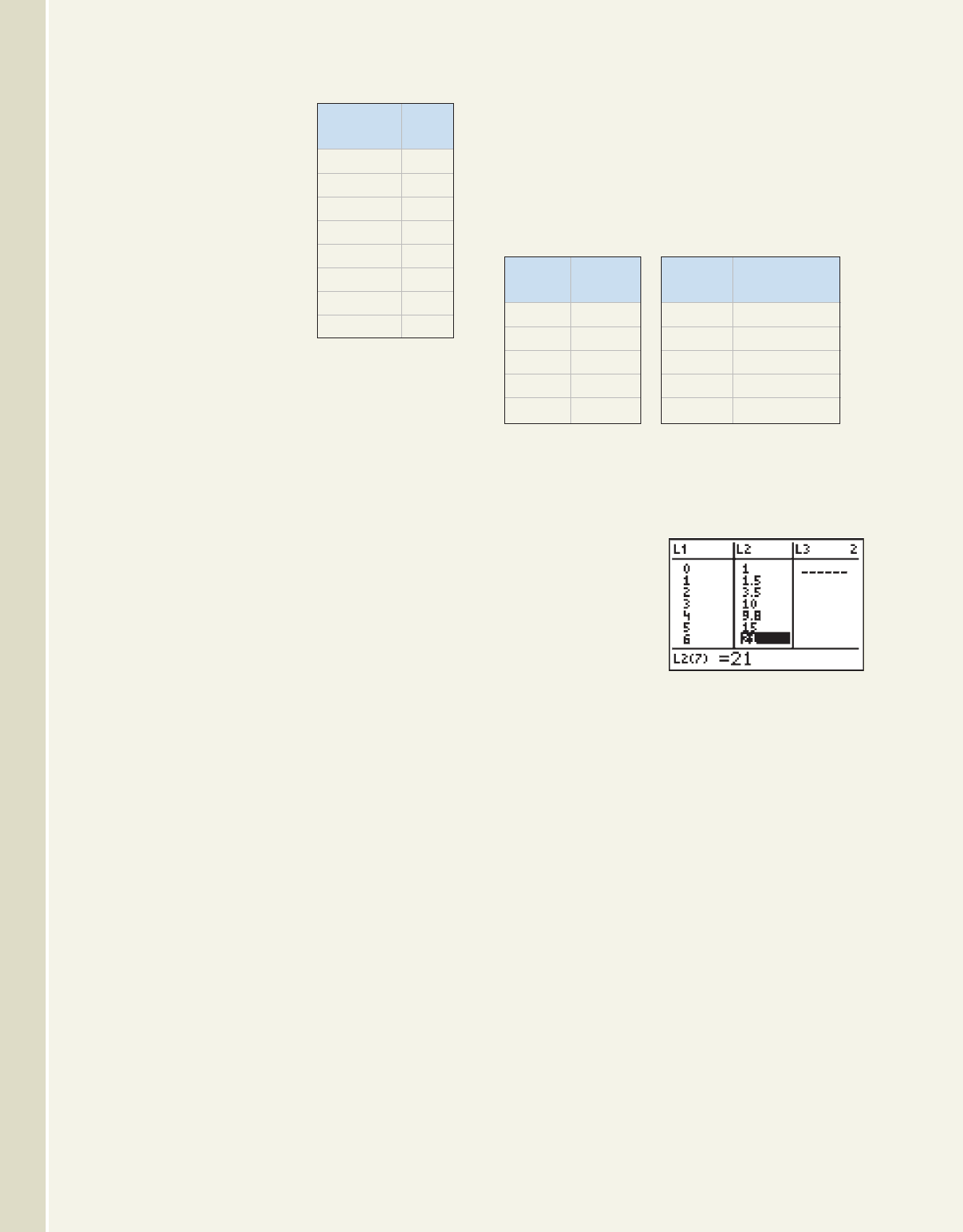
56. Children and AIDS:
Largely due to research,
education, prevention, and
better health care, estimates
of the number of AIDS
(acquired immune deficiency
syndrome) cases diagnosed
in children less than 13 yr of
age have been declining. Data
for the years 1995 through
2002 is given in the table.
Source: National Center for Disease
Control and Prevention.
a. Use the data to draw a scatter-plot and decide
on an appropriate form of regression.
b. Find a regression equation that models the
data. According to the model, how many cases
of AIDS in children are projected for 2010?
c. In what year did the number of cases fall
below 50?
57. Growth rates of children: After reading a report
from The National Center for Health Statistics
regarding the growth of children from age 0 to 36
months, Maryann decides to track the relationships
(length in inches, weight in pounds) and (age in
months, circumference of head in centimeters) for
her newborn child, a beautiful baby girl—Morgan.
a. Use the (length, weight) data to draw a scatter-
plot, then use the context and scatter-plot to
find the regression equation. According to the
model, how much will Morgan weigh when
she reaches a height (length) of 39 in.? What
will her length be when she weighs 28 lb?
b. Use the (age, circumference) data to draw a
scatter-plot, then use the context and
58. Correlation coefficients: Although correlation
coefficients can be very helpful, other factors must
also be considered when selecting the most
appropriate equation model for a set of data. To see
why, use the data
given to (a) find a
linear regression
equation and note
its correlation
coefficient, and
(b) find an
exponential
regression equation and note its correlation
coefficient. What do you notice? Without knowing
the context of the data, would you be able to tell
which model might be more suitable? (c) Use your
calculator to graph the scatter-plot and both
functions. Which function appears to be a better fit?
502 Modeling with Technology II Exponential, Logarithmic, and Other Regression Models MWTII–12
Years
Since 1990 Cases
5 686
6 518
7 328
8 238
9 183
10 118
11 110
12 92
Length Weight
(in.) (lb)
17.5 5.50
21 10.75
25.5 16.25
28.5 19.00
33 25.25
Age Circumference
(months) (cm)
1 38.0
6 44.0
12 46.5
18 48.0
21 48.3
Exercise 57b
Exercise 57a
College Algebra—
scatter-plot to find the regression equation.
According to the model, what is the
circumference of Morgan’s head when she is
27 months old? How old will she be when the
circumference of her head is 50 cm?
cob19413_ch0MWT_491-502.qxd 30/10/2008 05:09 PM Page 502 EPG 204:MHDQ069:mhcob%0:cob2chMWT2:

r
ain dro
p
An Introduction
to Trigonometric
Functions
CHAPTER OUTLINE
5.1 Angle Measure, Special Triangles, and
Special Angles 504
5.2 The Trigonometry of Right Triangles 518
5.3 Trigonometry and the Coordinate Plane 531
5.4 Unit Circles and the Trigonometry of
Real Numbers 542
5.5 Graphs of the Sine and Cosine Functions;
Cosecant and Secant Functions 557
5.6 Graphs of Tangent and Cotangent Functions 574
5.7 Transformations and Applications of
Trigonometric Graphs 587
5
5
CHAPTER CONNECTIONS
While rainbows have been admired for
centuries for their beauty and color, under-
standing the physics of rainbows is of fairly
recent origin. Answers to questions regarding
their seven-color constitution, the order the
colors appear, the circular shape of the bow,
and their relationship to moisture, all have
answers deeply rooted in mathematics. The
relationship between light and color can be
understood in terms of trigonometry, with
questions regarding the apparent height of
the rainbow, as well as the height of other
natural and man-made phenomena, found
using the trigometry of right triangles. This
application appears as Exercise 85 in
Section 5.2
Check out these other real-world connections:
Determining the Area Monitored by a Motion
Detector (Section 5.1, Exercise 98)
Determining the Height of Taipei 101, World’s
Tallest Building (Section 5.2, Exercise 80)
Identifying Various Colors Using Their
Wavelengths (Section 5.5, Exercise 69)
Modeling the Number of Daylight Hours for
Cities at Various Latitudes
(Section 5.7, Exercise 55)
503
College Algebra & Trignometry—
cob19529_ch05_503-518.qxd 01/13/2009 07:29 PM Page 503 ssen 1 HD 049:Desktop Folder:Satya 13/01/09:Used file:MHDQ092-5.1:
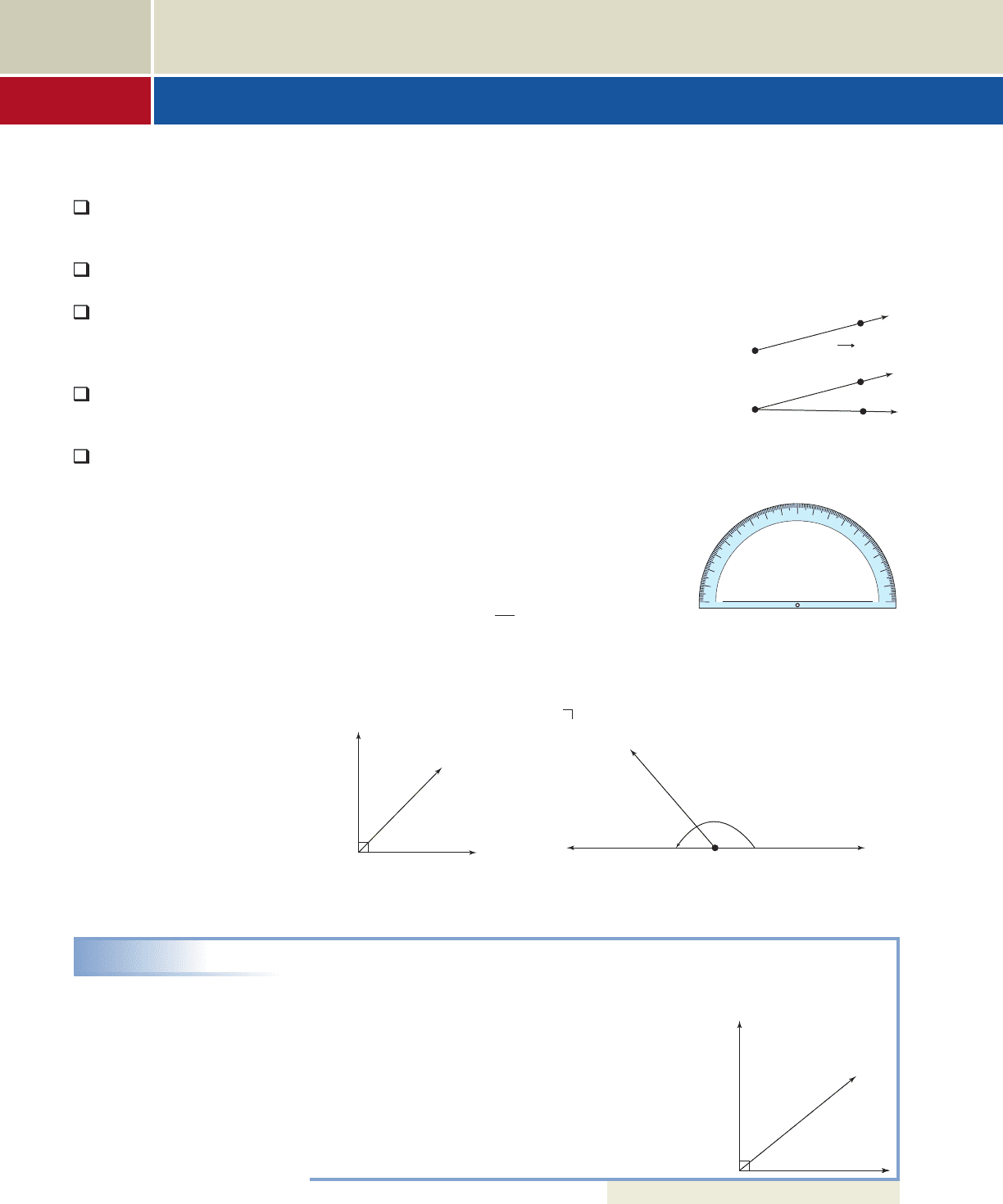
Trigonometry, like her sister science geometry, has its origins deeply rooted in the prac-
tical use of measurement and proportion. In this section, we’ll look at the fundamental
concepts on which trigonometry is based, which we hope will lead to a better under-
standing and a greater appreciation of the wonderful study that trigonometry has become.
A. Angle Measure in Degrees
Beginning with the common notion of a straight line, a ray
is a half line, or all points extending from a single point, in
a single direction. An angle is the joining of two rays at a
common endpoint called the vertex. Arrowheads are used
to indicate the half lines continue forever and can be
extended if necessary. Angles can be named using a single
letter at the vertex, the letters from the rays forming the
sides, or by a single Greek letter, with the favorites being
alpha , beta , gamma and theta The symbol is
often used to designate an angle (see Figure 5.1).
Euclid (325–265
B.C.), often thought of as the
father of geometry, described an angle as “the incli-
nation of one to another of two lines which meet in a
plane.” This amount of inclination gives rise to the
common notion of angle measure in degrees, often
measured with a semicircular protractor like the one
shown in Figure 5.2. The notation for degrees is the
symbol. By definition is of a full rotation, so this
protractor can be used to measure any angle from (where the two rays are coinci-
dent), to (where they form a straight line). An angle measuring is called a
straight angle, while an angle that measures is called a right angle. Two angles
that sum to are said to be complementary, while two that sum to are
supplementary angles. Recall the “ ” symbol represents a angle.90°
180°90°
90°
180°180°
0°
1
360
1°
°
.,
Learning Objectives
In Section 5.1 you will learn how to:
A. Use the vocabulary
associated with a study
of angles and triangles
B. Find fixed ratios of the
sides of special triangles
C. Use radians for angle
measure and compute
circular arc length and
area using radians
D. Convert between
degrees and radians for
nonstandard angles
E. Solve applications
involving angular
velocity and linear
velocity using radians
5.1 Angle Measure, Special Triangles, and Special Angles
Figure 5.2
College Algebra & Trignometry—
504 5-2
80
90
90
70
60
50
40
30
20
10
100
110
120
130
140
150
160
170
180
0
100
110
120
130
140
150
160
170
80
70
60
50
40
30
20
10
0
180
A
B
Ray AB
A
B
C
Vertex
angle
A BAC
Figure 5.1
and are complementary
or
and are complements
90
180
and are supplementary
or
and are supplements
EXAMPLE 1
Finding the Complement and Supplement of an Angle
Determine the measure of each angle described.
a. the complement of a angle b. the supplement of a angle
c. the measure of angle shown in the figure
Solution
a. The complement of is since
b. The supplement of is since
c. Since and are complements,
Now try Exercises 7 through 10
90 39 51°.
39°
180 132 48° 1 48 132 180°.
48°132°
90 57 33° 1 33 57 90°.
33°57°
132°57°
39
cob19529_ch05_503-614.qxd 11/11/08 1:44 PM Page 504 epg HD 049:Desktop Folder:Coburn_do_t del-ch05:
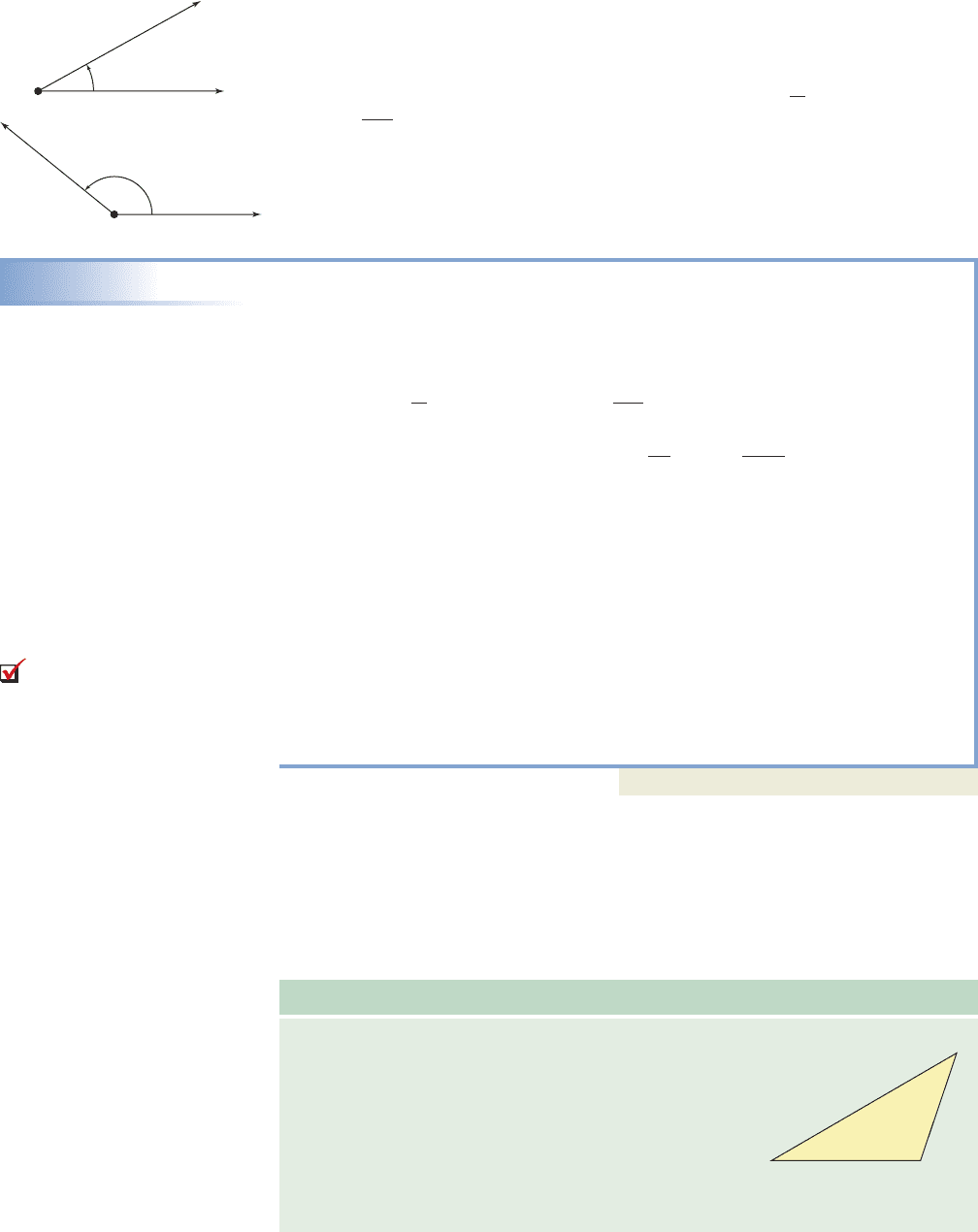
5-3 Section 5.1 Angle Measure, Special Triangles, and Special Angles 505
In the study of trigonometry, it helps to further classify the various angles we
encounter. An angle greater than but less than is called an acute angle. An angle
greater than but less than is called an obtuse angle. For very fine measurements,
each degree is divided into 60 smaller parts called minutes, and each minute into
60 smaller parts called seconds. This means that a minute is of a degree, while a
second is of a degree. The angle whose measure is “sixty-one degrees, eighteen
minutes, and forty-five seconds” is written as . The degrees-minutes-seconds
(DMS) method of measuring angles is commonly used in aviation and navigation,
while in other areas decimal degrees such as are preferred. You will some-
times be asked to convert between the two.
EXAMPLE 2
Converting Between Decimal Degrees and Degrees/Minutes/Seconds
Convert as indicated.
a. to decimal degrees
b. to DMS
Solution
a. Since of a degree and of a degree, we have
b. For the conversion to DMS we write the fractional part separate from the
whole number part to compute the number of degrees and minutes represented,
then repeat the process to find the number of degrees, minutes, and seconds:
separate fractional part from the whole
; substitute for
result in degrees and minutes
separate fractional part from the whole
; substitute for
result in degrees, minutes, and seconds
Now try Exercises 11 through 26
B. Triangles and Properties of Triangles
A triangle is a closed plane figure with three straight sides and three angles. It is cus-
tomary to name each angle using a capital letter and the side opposite the angle using
the corresponding lowercase letter. Regardless of their size or orientation, triangles
have the following properties.
Properties of Triangles
Given triangle ABC with sides a, b, and c respectively,
I. The sum of the angles is
II. The combined length of any two sides exceeds
that of the third side:
and
III. Larger angles are opposite larger sides:
If then c 7 b.C 7 B,
b c 7 a.a b 7 c, a c 7 b,
A B C 180°
180°:
142° 12¿ 27–
1¿60–0.45¿ 0.45
#
1¿ 142° 12¿ 0.451602–
142° 12¿ 0.45¿
142° 12.45¿
1°60¿0.2075° 0.2075
#
1° 142° 0.20751602¿
142.2075° 142° 0.2075°
61.3125°
61° 18¿ 45– c61 18a
1
60
b 45a
1
3600
bd
°
1–
1
3600
1¿
1
60
142.2075°
61° 18¿ 45–
61.3125°
61° 18¿ 45–
1
3600
1
60
180°90°
90°0°
A. You’ve just learned how
to use the vocabulary associ-
ated with a study of angles
and triangles
Acute
Obtuse
^ ABC
b
c
a
C
A
B
College Algebra & Trignometry—
cob19529_ch05_503-614.qxd 11/11/08 1:44 PM Page 505 epg HD 049:Desktop Folder:Coburn_do_t del-ch05:
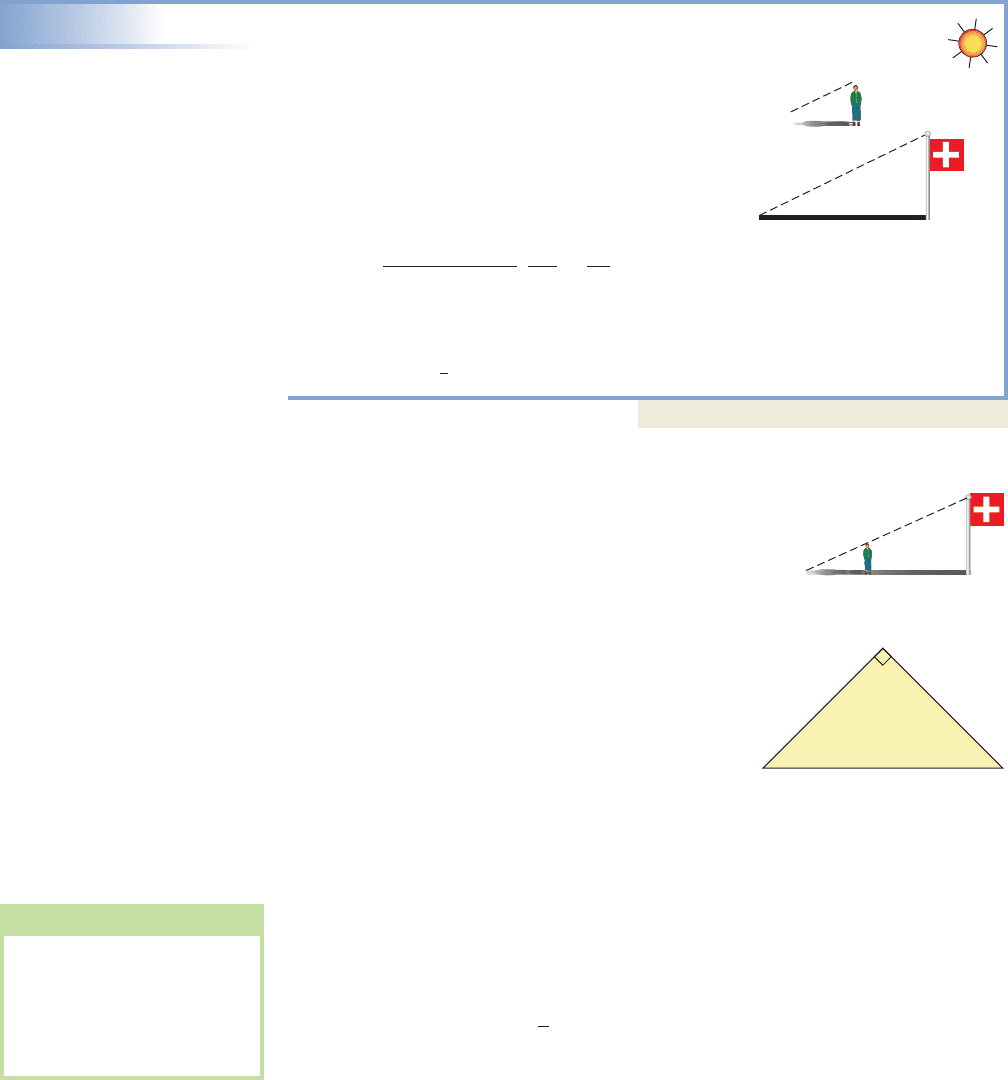
506 CHAPTER 5 An Introduction to Trigonometric Functions 5-4
Two triangles are similar triangles if corresponding angles are equal, meaning for
and , and . Since antiquity it’s been known that
if two triangles are similar, corresponding sides are proportional (corresponding sides
are those opposite the equal angles from each triangle). This relationship, used exten-
sively by the engineers of virtually all ancient civilizations, is very important to our
study of trigonometry. Example 3 illustrates how proportions and similar triangles are
often used.
EXAMPLE 3
Using Similar Triangles to Find Heights
To estimate the height of a flagpole, Carrie
reasons that formed by her height and
shadow must be similar to formed by the
flagpole. She is 5 ft 6 in. tall and casts an 8-ft
shadow, while the shadow of the flagpole
measures 44 ft. How tall is the pole?
Solution
Let H represent the height of the flagpole.
original proportion,
cross multiply
result
The flagpole is tall (30 ft 3 in.).
Now try Exercises 27 through 34
Figure 5.3 shows Carrie standing along the shadow of
the flagpole, again illustrating the proportional relation-
ships that exist. Early mathematicians recognized the
power of these relationships, realizing that if the triangles
were similar and the related fixed proportions were known,
they had the ability to find mountain heights, the
widths of lakes, and even the ability to estimate the
distance to the Sun and Moon. What was needed was
an accurate and systematic method of finding these
“fixed proportions” for various angles, so they could
be applied more widely. In support of this search, two
special triangles were used. These triangles, com-
monly called 45-45-90 and 30-60-90 triangles, are
special because no estimation or interpolation is
needed to find the relationships between their sides.
For the first, consider an isosceles right triangle—a right triangle with two equal sides
and two angles (Figure 5.4). After naming the equal sides x and the hypotenuse
h, we can apply the Pythagorean theorem to find a relationship between the sides and
the hypotenuse in terms of x.
Pythagorean theorem
substitute x for a, x for b, and h for c
combine like terms
solve for
This important result is summarized in the following box.
h 1h 7 02 h 12x
2x
2
h
2
x
2
x
2
c
2
a
2
b
2
45°
30
1
4
ft
H 30.25
8 H 242
5¿ 6– 5.5 ft
Height
Shadow Length
:
5.5
8
H
44
^DEF
^ABC
C F^DEF, A D, B E^ABC
WORTHY OF NOTE
Recall that the Pythagorean
theorem states that for any
right triangle, the sum of the
squares of the two legs, is
equal to the square of the
hypotenuse: .a
2
b
2
c
2
D
C
B
A
E
F
Carrie
Figure 5.3
45
45
h
xx
Figure 5.4
College Algebra & Trignometry—
cob19529_ch05_503-518.qxd 12/29/08 4:47 PM Page 506 epg HD 049:Desktop Folder:Satya 29/12/08:Coburn_do_t del-ch05:MHDQ092-5.1:
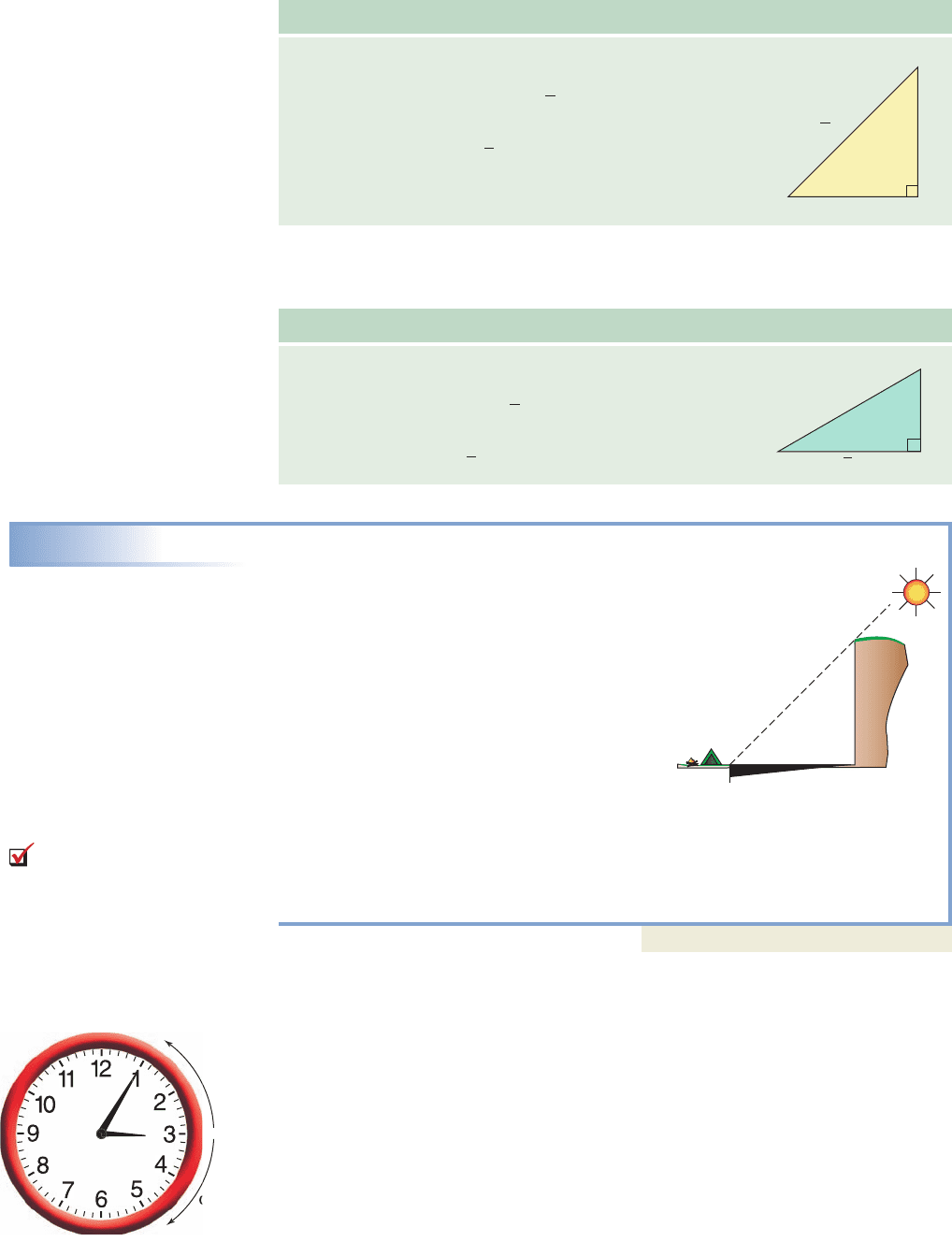
5-5 Section 5.1 Angle Measure, Special Triangles, and Special Angles 507
45-45-90 Triangles
Given a 45-45-90 triangle with one side of length x, the
relationship between corresponding sides is:
(1) The two legs are equal
(2) The hypotenuse is times the length of either leg.
The proportional relationship for a 30-60-90 triangle is developed in Exercise 110,
and the result is stated here.
30-60-90 Triangles
Given a 30-60-90 triangle with the shortest side of length
x, the relationship between corresponding sides is:
(1) The hypotenuse is 2 times the length of the shorter leg,
(2) The longer leg is times the length of the shorter leg.
EXAMPLE 4
Applications of 45-45-90 Triangles: The Height of a Cliff
A group of campers has pitched their tent some
distance from the base of a tall cliff. The
evening’s conversation turns to a discussion of
the cliff’s height, and they all lodge an estimate.
Then one of them says, “Wait . . . how will we
know who’s closest?” Describe how a 45-45-90
triangle can help determine a winner.
Solution
In the morning, cut a pole equal in height to any
of the campers. Then follow the shadow of the
cliff as it moves, with the selected camper
occasionally laying the pole at her feet and checking her shadow’s length against
the length of the pole. At the moment her shadow is equal to the pole’s length, the
sun is shining at a angle and the campers can use the pole to measure the
shadow cast by the cliff (by counting the number of pole lengths needed to reach
it), which will be equal to its height since a 45-45-90 triangle is formed.
Now try Exercises 35 and 36
C. Angle Measure in Radians; Arc Length and Area
As an alternative to viewing angles as “the amount of inclination” between two rays,
angle measure can also be considered as the amount of rotation from a fixed ray called
the initial side, to a rotated ray called the terminal side. This enables angle measure
to be free from the context of a triangle, and allows for positive or negative angles,
depending on the direction of rotation. Angles formed by a counterclockwise rotation
are considered positive angles, and angles formed by a clockwise rotation are nega-
tive angles (see Figure 5.5). We can then name an angle of any size, including those
greater than where the amount of rotation exceeds one revolution. See Figures 5.6
through 5.10.
360°
45°
13
1x : 13 x : 2x.
12
1x : 1x : 12 x.
B. You’ve just learned how
to find fixed ratios of the
sides of special triangles
兹2 x
C
A
B
1
x
1x
45⬚
45⬚
Counter
-
cl
oc
kwi
s
e
Cl
oc
kwi
se
Figure 5.5
C
A
B
1x
兹3 x
2x
30⬚
60⬚
College Algebra & Trignometry—
cob19529_ch05_503-518.qxd 01/13/2009 07:29 PM Page 507 ssen 1 HD 049:Desktop Folder:Satya 13/01/09:Used file:MHDQ092-5.1:
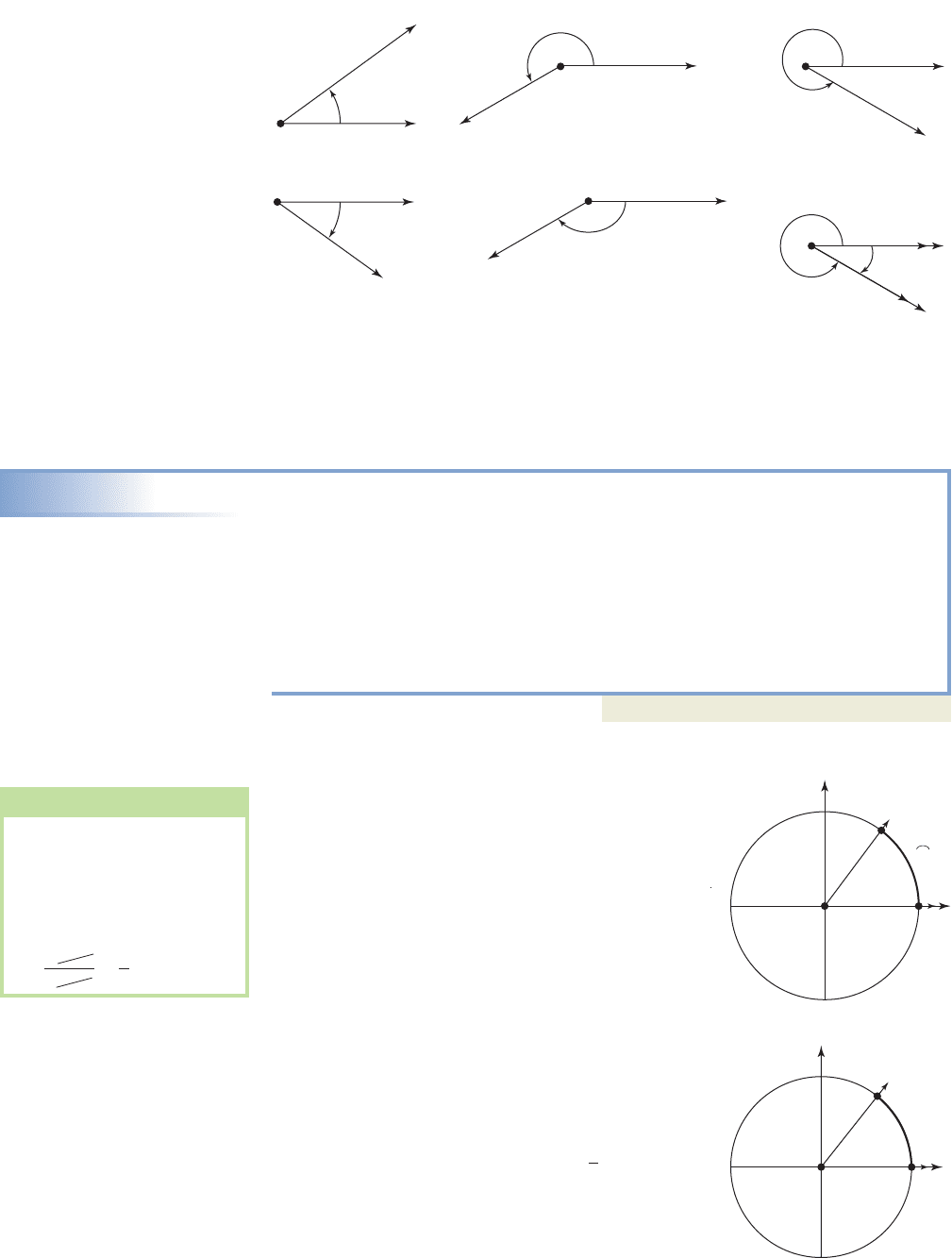
508 CHAPTER 5 An Introduction to Trigonometric Functions 5-6
Note in Figure 5.11 that angle and angle share the same
initial and terminal sides and are called coterminal angles. Coterminal angles will
always differ by , meaning for that any integer k, angles and will be
coterminal.
EXAMPLE 5
Finding Coterminal Angles
Find two positive angles and two negative angles that are coterminal with .
Solution
For .
For .
For .
For .
Note that many other answers are possible.
Now try Exercises 37 through 40
An angle is said to be in standard position in the
rectangular coordinate system if its vertex is at the
origin and the initial side is along the positive x-axis. In
standard position, the terminal sides of ,
and angles coincide with one of the axes and are
called quadrantal angles. To help develop these ideas
further, we use a central circle, that is, a circle in the
xy-plane with its center at the origin. A central angle is
an angle whose vertex is at the center of the circle. For
central angle intersecting the circle at points B and C,
we say circular arc BC, denoted , subtends
as shown in Figure 5.12. The letter s is commonly used
to represent arc length, and if we define 1 radian
(abbreviated rad) to be the measure of an angle sub-
tended by an arc equal in length to the radius, then
when (see Figure 5.13). We can then
find the radian measure of any central angle by dividing
the length of the subtended arc by radians.
Multiplying both sides by r gives a formula for the
length of any arc subtended on a circle of radius r:
if is in radians.s r
r:
s
r
s r 1 rad
BAC,
BC
360°
90°, 180°, 270°
k 2, 60° 360122 780°
k 1, 60° 360112 420°
k 1, 60° 360112300°
k 2, 60° 360122660°
60°
360k360°
30° 330°
Terminal side
Initial side
Positive angle
Positive angle
210
Positive angle
330
Negative angle
30
Negative angle
150
330
30
Coterminal angles
Figure 5.6
Figure 5.7
Figure 5.8
Figure 5.9
Figure 5.10
Figure 5.11
WORTHY OF NOTE
Using the properties of ratios,
we note that since both r
(radius) and s (arc length) are
measured in like units, the
units actually “cancel” making
radians a unitless measure:
.
s units
r units
s
r
A
B
Central angle BAC
BC
C
x
y
r
A
C
B
1 radian
r
s r
y
Figure 5.12
Figure 5.13
College Algebra & Trignometry—
cob19529_ch05_503-518.qxd 12/29/08 4:47 PM Page 508 epg HD 049:Desktop Folder:Satya 29/12/08:Coburn_do_t del-ch05:MHDQ092-5.1:

5-7 Section 5.1 Angle Measure, Special Triangles, and Special Angles 509
Radians
If central angle is subtended by an arc that is equal in length to the radius, then
Arc Length
If is a central angle in a circle of radius r, then the length of the subtended arc s is
,
provided is expressed in radians.
EXAMPLE 6
Using the Formula for Arc Length
If the circle in Figure 5.13 has radius , what is the length of the arc
subtended by an angle of 3.5 rad?
Solution
Using the formula with and gives
substitute 10 for r and 3.5 for
result
The subtended arc has a length of 35 cm.
Now try Exercises 41 through 52
Using a central angle measured in radians, we
can also develop a formula for the area of a circu-
lar sector (a pie slice) using a proportion. Recall
the circumference of a cicle is . While you
may not have considered this before, note the
formula can be written as which implies
that the radius, or an arc of length r, can be wrapped
around the circumference of the circle
times, as illustrated in Figure 5.14. This shows the
radian measure of a full rotation is
This can be verified as before, using
the relation The ratio
of the area of a sector to the total area will be identical to the ratio of the subtended
angle to one full rotation. Using to represent the area of the sector, we have
and solving for gives .
Area of a Sector
If is a central angle in a circle of radius r, the area of the sector formed is
,
provided is expressed in radians.
EXAMPLE 7
Using the Formula for the Area of a Sector
What is the area of the circular sector formed by a central angle of if the radius
of the circle is 72 ft? Round to tenths.
3
4
,
A
1
2
r
2
A
1
2
r
2
A
A
r
2
2
A
radians
s
r
2r
r
2.
2 rad 360°.
2:
360°
2 6.28
C 2
#
r,
C 2r
s 35
s 1013.52
3.5r 10s r
r 10 cm
s r
1 radian.
Figure 5.14
A
1
2
3
4
5
6
x
y
r
r
r
r
r
r
r
College Algebra & Trignometry—
cob19529_ch05_503-614.qxd 12/27/08 10:26 Page 509
